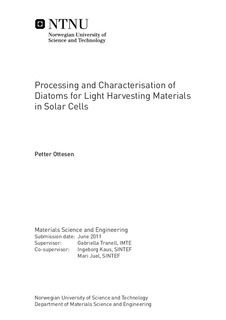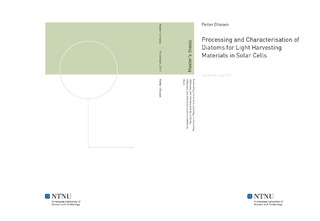| dc.description.abstract | By applying a texture to the front surface of solar cells, less light may be reflected and the incoming light may be given a longer path length inside the solar cell causing a better light absorbance for the solar cell. The textured layer is today made by etching with an acidic etch with a large part hydrogen fluoride. In the future a more environmental approach for creating textured solar cells may be favoured. There are many ways of creating textured surfaces, one of them are by imprinting the surface by a template, and remove the template when the process is completed.In this project the diatom species Coscinodiscus walesii and an undefined Coscinodiscus species were cleaned and processed for investigation. The work done can be divided into four tasks. The first was characterisation and investigation of the pore structure. The second were manufacturing and characterisation of gold for use as templates. The third were deposition and characterisation of thin films of silicon and silicon nitride on diatom frustules. The last part were to make structures are very similar to solar cells with diatom frustules incorporated into them.The diatom frustules were characterised by SEM and the pore structure were cut through with FIB to characterise the structure. There were structural differences between the two species. The Coscinodiscus walesii was grown in a cultivation chamber, and lacked the circular inner pore structure which the undefined Coscinodiscus species had. This was the only real difference between the two species.On the cultivated species were deposited a gold film, which a small rectangle were lifted off by a tungsten needle in FIB. The small rectangle were characterised with the SEM-column in a dual beam FIB. Pore structures down to 40 nm were replicated by the gold film lifted off the frustule. By depositing a relatively thick film of gold on a glass substrate covered with diatom frustules and dissolving the glass substrate and diatom frustules with hydrogen fluoride, a template were made with a replication of the diatom frustule pore structure.Silicon and silicon nitride were deposited on diatom frustules and characterised with FIB to investigate how those materials followed the frustule topography. A good conformity of films made of those materials was confirmed, and 4 different samples which were similar to solar cells were manufactured and characterised by light microscopy, SEM and FIB. Two samples were made to be similar to crystalline silicon solar cells. One had dried frustules on top of a silicon surface and the entire surface of the sample were coated with silicon nitride, a blue colour were observed in the entire surface and the silicon nitride had also been deposited on the diatom frustules. For the other sample similar to crystalline silicon solar cells another layer were deposited between the frustule and the silicon substrate. The double silicon layer made the sample surface yellow, the diatom frustules did not get darker due to a layer above and a layer beneath them. Only in some places where the frustules had loosened from the sample the sample were blue as the silicon nitride layer were the same as a single layer of silicon nitride. For the last two samples, thin film solar cell structures based on amorphous silicon deposited with PECVD were made. A sample there a aluminum coating were deposited on a glass substrate and diatom frustules were dried on top of the aluminum coating, afterwards a 5 µm thick film of amorphous silicon were deposited. SEM images showed that the film were distributed even across a diatom frustule and a light microscopy investigation showed that light were spread when it hit the diatom frustules, hence creating a longer mean path through the solar cell. | nb_NO |

